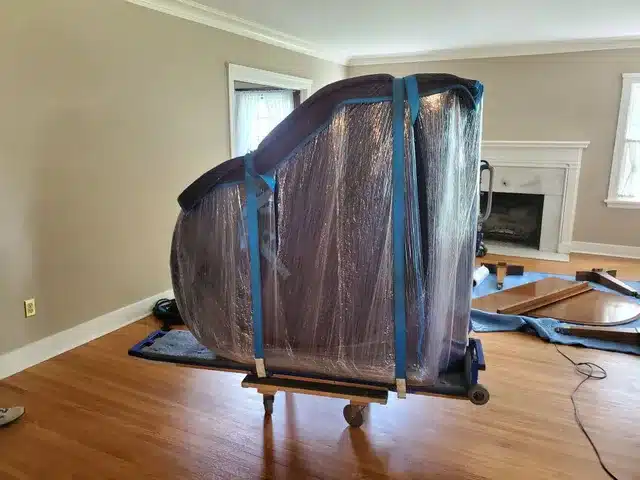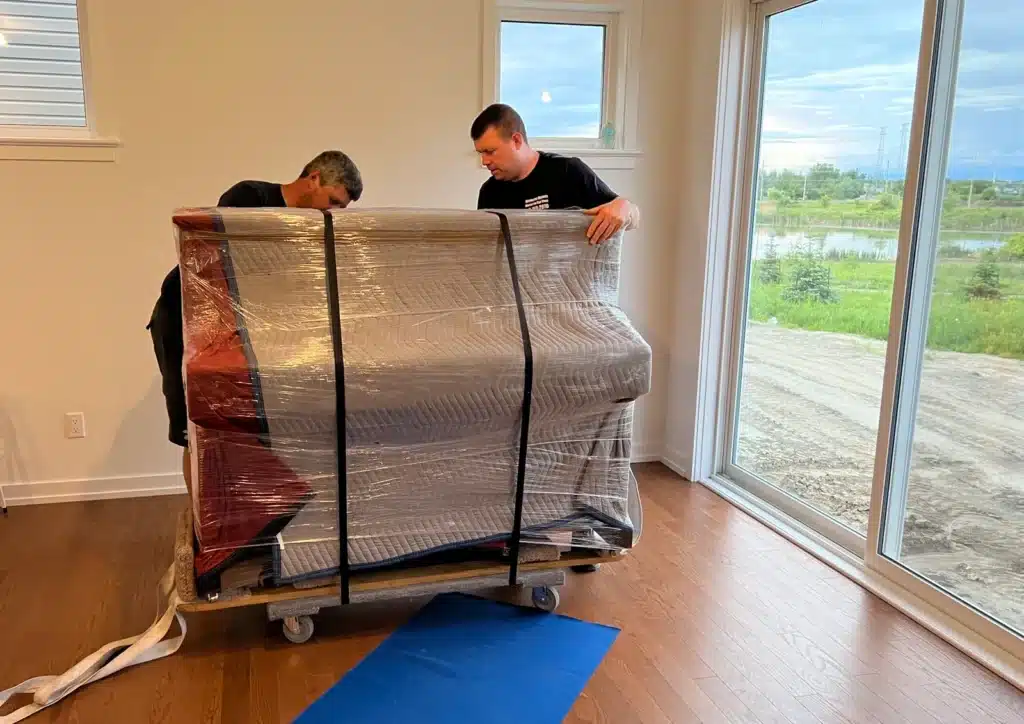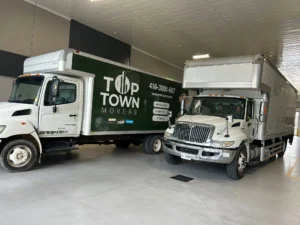The majestic presence of a piano can define a room, but sometimes, a simple redecoration or renovation means that grand or upright needs to shift. The question “How to move a piano across the room?” might seem less daunting than a full-scale relocation across town, but make no mistake: even a short journey for this heavy, delicate, and often sentimental instrument comes with significant challenges and risks.
At Top Town Movers, serving Ontario and the North York area, we receive frequent inquiries about minor piano adjustments. While this article will delve into the theoretical steps involved in how to move a piano across the room, our strongest recommendation, born from years of experience as professional piano movers, is always to entrust this task to experts. Pianos are incredibly heavy, incredibly sensitive, and incredibly prone to damage if not handled with precision and specialized equipment.3
- Learn More >>>> Piano moving
How to Move a Piano Across the Room: A Guide (and Why Professionals Are Always Best)
The Inherent Risks: Why “How to Move a Piano Across the Room” Is More Complex Than It Seems
Before even considering the “how-to,” it’s crucial to understand the inherent dangers and complexities involved in moving a piano, even for a short distance:
- Immense Weight: Even a small upright piano can weigh 300-500 pounds, while grand pianos often exceed 1,000 pounds. This is not just heavy; it’s an extreme amount of concentrated weight that can easily damage floors, walls, and most importantly, people.
- Uneven Weight Distribution: Pianos are not uniformly weighted.4 Their mass is often concentrated in specific areas, making them incredibly awkward to lift and balance.5
- Delicate Internal Mechanisms: The action, strings, and soundboard of a piano are exquisitely sensitive.6 Even a slight jolt, tilt, or impact can knock the thousands of parts out of alignment, leading to costly repairs and affecting the instrument’s sound and playability.7
- Fragile Exterior Finish: Most pianos have a beautiful, often high-gloss finish that is easily scratched, chipped, or dented.8 Protecting this aesthetic integrity is paramount.
- Risk of Personal Injury: Strains, sprains, crushed fingers, back injuries, and even broken bones are very real possibilities when attempting to move a heavy, unwieldy object without proper training, technique, and equipment.9
- Property Damage: Scratched floors, gouged walls, broken doorframes, or damaged stairs are common casualties when inexperienced individuals try to maneuver a piano.10
- Lack of Proper Equipment: Most households do not possess the specialized tools required for safe piano movement, such as piano dollies, skids, and heavy-duty moving straps.
- Learn More >>>> How much did it cost to move a piano?
When NOT to Attempt Moving a Piano Yourself (Even Across the Room)
If any of the following apply, you absolutely should not attempt to move your piano, regardless of how short the distance:
- You don’t have at least three strong, capable adults. (And even then, this is often insufficient for safety.)
- The piano needs to go up or down even one step. Any change in elevation significantly increases risk.
- The path involves tight turns, narrow doorways, or uneven flooring.
- You lack proper moving equipment (piano dolly, moving blankets, heavy-duty straps).
- Your floor is not perfectly level and strong enough to handle the concentrated weight being dragged or rolled.
- You are uncomfortable with the potential for serious injury or damage.
For all these reasons, Top Town Movers, your trusted residential moving experts Toronto and North York, always recommends professional intervention.
- Learn More >>>> Piano Moving North York
Theoretical Steps: How to Move a Piano Across the Room (with Extreme Caution)
If, against strong advice, you are determined to attempt moving your piano a short distance yourself, here are the theoretical steps. Please proceed with the utmost caution, prioritizing safety above all else.
A. Essential Preparation: Before You Even Touch the Piano
- Assess the Path:
- Clear the way: Completely clear the entire path from the piano’s current location to its new spot. Remove rugs, furniture, toys, power cords, and anything that could be a tripping hazard or an obstacle.
- Measure: Measure doorways, hallways, and any tight spots to ensure the piano will fit. Take into account the height, width, and depth of the piano.
- Protect the Floor: Lay down heavy-duty floor protection (thick moving blankets, plywood, or specialized floor runners) along the entire path. Standard cardboard will not be sufficient. Pianos can leave indentations or scratches even when rolled on dollies.
- Prepare the Destination: Ensure the new spot is clean, clear, and ready to receive the piano.
- Gather Your Team:
- Minimum of three to four strong, able-bodied adults. Ensure everyone understands the plan, the risks, and their specific role. Communication is paramount.
- No children or pets in the area. This is a safety hazard.
- Acquire Proper Equipment (Absolutely Non-Negotiable):
- Piano Dolly: This is not a standard furniture dolly. A piano dolly is specifically designed to be low to the ground, wide, and incredibly sturdy, often with non-marring wheels.11 Renting one from a moving equipment supplier is essential.
- Heavy-Duty Moving Blankets: Multiple thick, padded blankets are needed to protect the piano’s finish.12
- Strong Moving Straps: At least two heavy-duty furniture straps (forearm forklifts are not designed for pianos and should be avoided for this task).
- Work Gloves: To ensure a good grip and protect hands.13
- Learn More >>>> Oakville Moving

B. Securing and Preparing the Piano (Upright Pianos)
- Close and Lock the Lid: Ensure the keyboard lid is closed and, if possible, locked. If it doesn’t lock, gently tape it closed with painter’s tape that won’t damage the finish.
- Secure the Bench: Move the piano bench separately. Do NOT try to move the piano with the bench attached or on top.
- Wrap the Piano: Carefully wrap the entire piano with multiple layers of heavy-duty moving blankets. Secure the blankets tightly with stretch wrap or painter’s tape, ensuring no part of the finish is exposed. Pay special attention to corners and edges.
- Identify Lifting Points: For uprights, the strongest points are typically the bottom corners and the solid frame behind the keyboard. Avoid lifting by the legs or decorative elements.
- Learn More >>>> Piano Moving Richmond Hill
C. Lifting and Placing onto a Dolly (Upright Pianos)
This is the most critical and dangerous step. Incorrect lifting can cause severe injury or irreparable damage.14
- Position the Dolly: Have the piano dolly positioned parallel to one side of the piano, ready to be slid underneath.
- Team Lift:
- Two people on one side of the piano, one or two people on the opposite side.
- Carefully, and in unison, slowly tilt the piano just enough to allow the dolly to be slid underneath its heaviest point (usually near the middle-bottom).
- The goal is to get the piano balanced securely on the dolly. It should sit flat and stable, not rocking.
- Ensure the piano is centered on the dolly to prevent tipping.
- Lower Gently: Once the dolly is in place, slowly and carefully lower the piano onto it.
- Strap if Necessary: If the dolly has straps, use them to secure the piano to the dolly for added stability, though for short, flat moves, a well-balanced piano may not strictly require it if the path is perfectly smooth.
- Learn More >>>> How much to move a piano in Toronto?
D. Moving the Piano (Upright Pianos)
- Maintain Control: One person should be at each end of the piano, guiding it. One person can be positioned to push from the back, ensuring controlled movement.
- Slow and Steady: Push the piano slowly across the room. Do not rush.
- Watch for Obstacles: Constantly monitor the path for any unexpected objects or unevenness.
- No Pivoting on Castors: Never try to pivot an upright piano on its small, original castors. These are for minor adjustments only and will break under the stress, damaging both the piano and your floor. The dolly bears the weight.
E. Removing from Dolly and Final Placement (Upright Pianos)
- Position at Destination: Carefully maneuver the piano exactly into its new desired spot.
- Reverse Lift: Carefully tilt the piano just enough to slide the dolly out from underneath.
- Lower Gently: Slowly and in unison, lower the piano to the floor.
- Unwrap: Remove all blankets and tape.
- Clean Up: Collect all moving materials and inspect the floor for any damage.
Grand Pianos: An Even Greater Challenge
Moving a grand piano, even across the room, is significantly more complex and dangerous than moving an upright. It almost always requires partial disassembly (legs and pedals) and specialized equipment like a grand piano skid or board. Attempting to do this without professional training and equipment is extremely ill-advised and carries a very high risk of irreparable damage to the piano and severe injury.
- Learn More >>>> Is it worth it to move a piano?
The True Answer to “How to Move a Piano Across the Room”: Call the Professionals
After outlining the arduous and risky steps involved, the most responsible advice for “How to move a piano across the room” remains unchanged: hire professional piano movers.
Here’s why Top Town Movers, serving Ontario and specifically North York, is your best and safest solution:
- Expertise and Experience: Our teams are not just general movers; they are highly trained specialists in piano relocation. They understand the mechanics, weight distribution, and fragility of every piano type.
- Specialized Equipment: We possess the right tools for the job – custom-designed piano dollies, heavy-duty skids, piano straps, hoisting equipment for tricky situations, and the best protective padding. This equipment is designed to move pianos safely and efficiently, something a DIY approach simply cannot replicate.
- Safety First: Our movers employ proper lifting techniques, communication protocols, and safety procedures to protect your piano, your property, and themselves. We minimize the risk of injury and damage.
- Insurance Coverage: In the rare event of an unforeseen incident, your piano is covered by our comprehensive insurance, providing crucial peace of mind that a DIY move cannot offer.
- Efficiency and Convenience: We handle all the logistics, planning, and heavy lifting, allowing you to focus on other aspects of your home’s rearrangement or renovation. We save you time, effort, and potential chiropractor bills!
- Protecting Your Investment: A piano is a significant financial and often sentimental investment. Entrusting it to professionals ensures it retains its value and remains in pristine condition.
- Preventing Damage: We know how to navigate tight spaces, stairs (even one step is a big deal for a piano!), and delicate flooring without leaving a mark.
Even if you’re just shifting your cherished instrument a few feet, the potential cost of damage or injury far outweighs the expense of hiring professionals. When considering “How to move a piano across the room,” remember that the safest and most reliable answer is always to reach out to experienced piano movers.
- Learn More >>>> piano moving Toronto
Contact Top Town Movers Today
Don’t risk your valuable piano or your personal safety. For any piano movement, large or small, across Ontario or within the North York area, Top Town Movers is your trusted partner. Our residential moving experts Toronto and piano specialists are ready to provide a seamless, safe, and stress-free solution.
Contact Top Town Movers today for a free, no-obligation quote. Let us handle the heavy lifting, so you can enjoy your perfectly placed piano in its newly arranged space. Your piano, and your back, will thank you.

































